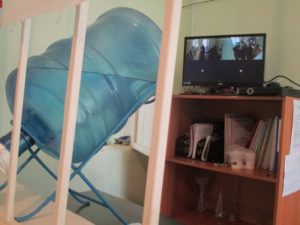 Author: Olga Ochneva, Kyrgyzstan
Author: Olga Ochneva, Kyrgyzstan
Since January 2018, HIV and tuberculosis programmes in Kyrgyzstan are funded from the new, significantly reduced grant of the Global Fund. There were six months of discussions concerning cost optimization and reduction, taking into account the growing deficit of funds that the country is facing in the nearest three years. The cost-saving mode has already been introduced, first of all affecting the prevention programmes.
Services and coverage are retained
In 2018-2020, Kyrgyzstan will receive 23.4 million US dollars for HIV and tuberculosis response from the Global Fund. For the reference, the previous Global Fund grant stipulated allocation of 20.8 million US dollars for the period twice shorter. The country decided to cut the expenditures gradually. The first six-month cost-saving period started in January 2018. According to Oksana Katkalova, the representative of the UNDP country office, which administers the Global Fund grants in Kyrgyzstan, treatment and diagnostics have been defined as the priorities and prevention interventions have been significantly cut down due to the reduced number of partner organisations.
“The money will be mainly used to purchase anti-tuberculosis and antiretroviral medicines (antiretroviral therapy or ART is a method of HIV treatment) as the number of people who need treatment is growing,” says Oksana Katkalova, HIV Grant Coordinator, UNDP. “We try to retain the services and the coverage, while optimising and reducing the administrative costs.”
Since the beginning of the year, two methadone maintenance treatment (MMT) sites have been closed, with patients referred to the nearest sites. The MMT clients will no longer receive the community support of some non-governmental organisations (NGOs), which used to be financed by the Global Fund. The number of implementing NGOs which receive funding has been diminished. Two NGOs working with people living with HIV (PLWH) in Bishkek and Osh will not be funded, with their services being consolidated and handed over to the organisations, which still get the funding. In smaller towns, services for different key populations have also been consolidated.
“One organisation working with different key populations is quite a good option for smaller regions. It allows saving costs for administrative personnel,” explains Oksana Katkalova. “When in a small town there are two organisations, one working with sex workers and the other one – with people who inject drugs (PWID), each with a coverage of 100-200 people, it makes sense to consolidate those services in one organisation if there is a shortage of resources. Our implementing partners – NGOs – have been selected through tender procedures and now have set coverage indicators, which mostly have been raised. However, they can and should engage outreach workers and peer counsellors for different key populations to reach the required coverage.”
Gender component reduced
The number of needle and syringe exchange points (NSPs) has been reduced from 21 to 15. Two of them used to operate in NGOs as service delivery sites. One of such sites was located in the Asteria residential community centre for women who inject drugs, with the Global Fund grant partly covering rental, personal services (accommodation, laundry, shower, meals, and hygiene packages) as well as the package of basic prevention services and consultations of an STI doctor.
“Unfortunately, the gender component for women who inject drugs has been excluded from the Global Fund project: diagnostics and treatment of sexually transmitted infections, hygiene packages and personal services are no longer available,” tells Irena Yermolayeva, director of the Asteria Charitable Foundation. “The Soros Foundation-Kyrgyzstan and the AIDS Foundation East-West in Kyrgyzstan agreed to cover the rental costs and partly the services for six months. We are doing our best to retain our residential project.”

Financial support of the four national networks has also been reduced. Now there will be one network promoting the rights and interests of all the key populations. Medical professionals working with PLWH also feel the shortage of funding. They receive benefits in addition to their salaries from the donor funds. Currently, the strategy of bonus reduction is continued, with shrinking resources, and the amount of the remaining benefits will depend on achieving the performance indicators. It is also planned to reduce payments to the medical personnel engaged in the MMT programme, but it is more complicated as in this case donor funds are the only source of financing. Just to remind that so far, the government has not allocated any money for the methadone maintenance treatment programme.
The programme aimed at the ART adherence improvement has also been cut. Before, all adherent patients used to get monthly motivation payments of 8 US dollars, while since January this year only children receive the allowances of about 14 US dollars, which are to be reduced by 2020.
By 2020, up to 30% of ART costs are to be covered by the state
The country will face even more funding cuts in the following two and a half years of project implementation. It is expected that four more MMT sites will be closed during this period. While in 2017, support within the Global Fund grant was provided to 26 NGOs, it is anticipated that by the end of 2020 only 10 of them will remain.
“So far, the smallest budget has been allocated for 2020 as it is planned that by this time the government will cover up to 30% of expenditures for the ART medicines; besides, we hope to have additional savings,” says Oksana Katkalova. “If during this period the government allocates significantly more funds, they can be used to purchase more ARTs, tests or, for example, to pay bonuses to the medical personnel engaged in HIV prevention, treatment, care and support programmes. Then we will be able to re-distribute part of the donor funds to cover prevention interventions. Every six months, we will adjust the expenditures for interventions and negotiate them in the format of a country dialogue. We hope that there will be a gradual increase in the scope of domestic funding.”



